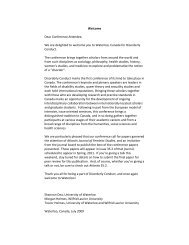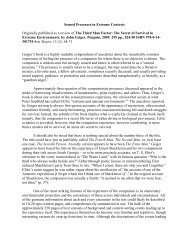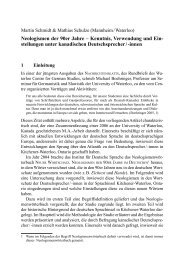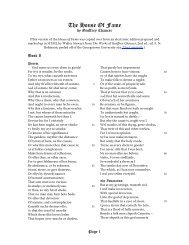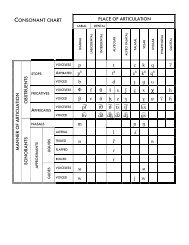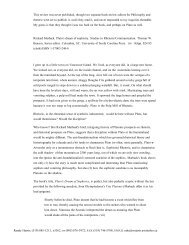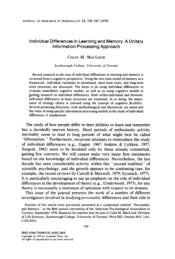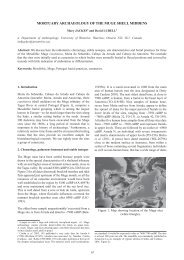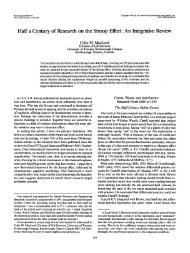The mid seventeenth century collapse of Iroquoian Ontario:
The mid seventeenth century collapse of Iroquoian Ontario:
The mid seventeenth century collapse of Iroquoian Ontario:
Create successful ePaper yourself
Turn your PDF publications into a flip-book with our unique Google optimized e-Paper software.
the Mid Seventeenth centuRy collapSe <strong>of</strong> iRoquoian on ta R i o<br />
From 1610 onwards, Huronia was only sporadically in direct recorded contact with<br />
Europeans, apart presumably from Brûlé. Until he was killed and eaten there in 1632 (JR, 10,<br />
p. 305), Brûlé was the only consistent European resident. Nevertheless, Europeans did go to<br />
Huronia for short periods: Champlain (Biggar, 1922-36, iv, p. 240) records encountering 13 or<br />
14 Frenchmen there in <strong>mid</strong>-August 1615. We know little <strong>of</strong> the fur traders since the written<br />
records are <strong>of</strong> Champlain or <strong>of</strong> missionaries who were originally Recollets, reformed<br />
Franciscans. Father Joseph Le Caron set out in July, 1615 for Huronia arriving only a few days<br />
before Champlain, and both he and Champlain stayed for a year. Le Caron returned to<br />
Huronia with two other Recollets, Father Viel and Brother Sagard, in 1623. A year later Viel<br />
was left on his own while the others went to France to beg for help from the Jesuits. He stayed<br />
alone for a year, leaving no record when he drowned in 1625 on the long and dangerous<br />
return journey to Quebec (via the northern trading route shown in fig. 2). In 1625, the Jesuit<br />
Jean de Brébeuf went to Huronia, accompanied from 1626 to 1629 by the Recollet de la Roche<br />
Daillon.<br />
From 1629 to 1632, New France was held for the British by the Kirke brothers (who were,<br />
in fact, French), and there were no trading expeditions from Huronia to the St. Lawrence<br />
valley (Charlevoix, ii, p. 66) 5 . With the return to French rule, a new spirit governed New<br />
France. Richelieu created the Company <strong>of</strong> New France with the idea <strong>of</strong> settling hundreds<br />
(specifically French and Roman Catholic) families in the colony. Trois Rivières was started in<br />
1633 (Butterfield, 1898, p. 151), Montreal nearly ten years later, bringing French settlers ever<br />
closer to aboriginal fur traders. <strong>The</strong>re were very few French Canadians in 1629-1633 (Eccles,<br />
1983, p. 24), including only one family (JR, 5, p. 41): it is worth noting that some had been<br />
captured and transported to England and that from 1629 until 1634 there was a great deal <strong>of</strong><br />
movement <strong>of</strong> people among England, Quebec and France – an ideal situation for the importation<br />
<strong>of</strong> disease. In March 1633, Champlain left Dieppe with a fleet <strong>of</strong> three vessels for the two<br />
month journey to Quebec. On board there were fur traders, soldiers, artisans, labourers, a<br />
woman and two children, about 200 in all, and others, including more children, followed<br />
(Dionne, 1912, p. 245, 252).<br />
<strong>The</strong> mission to the Huron was revived in 1634. <strong>The</strong> arrival <strong>of</strong> the Jesuits marks a more<br />
consistent record <strong>of</strong> what happened in <strong>Ontario</strong>, for it was incumbent upon the Jesuits to write<br />
letters and reports, mostly published as the Jesuit Relations. <strong>The</strong> letters <strong>of</strong> interest to us begin<br />
in 1634. From this time on, the ethos seems to have changed: missionary zeal, with a Counter-<br />
Reformation flavour to it, seems to have been more important than trade (Bosher, 1993) and<br />
the majority <strong>of</strong> the laymen known to be in <strong>Ontario</strong> had taken certain religious vows (Côté,<br />
1955). Nevertheless, trading expeditions to Quebec remained important to the Huron, and<br />
their enemies, the Iroquois, tried to disrupt it – so successfully that trade came to a complete<br />
halt in 1642-44 because <strong>of</strong> an Iroquois blockade. But it is obvious that from 1610, the almost<br />
5. Jean Nicollet, interpreter and explorer, is said to have taken refuge with the Huron and persuaded them<br />
not to trade with the English. He was evidently more devoutly Catholic and loyal to the French than Brûlé<br />
(compare JR, 9, p. 215-217 on Nicollet’s devotion, with Sagard 1939, p. 171, on rebuking Brûlé for engaging<br />
in native practices), whereas Brûlé assisted the English takeover <strong>of</strong> Quebec (JR, 5, p. 241; Charlevoix, ii,<br />
p. 50).<br />
351



